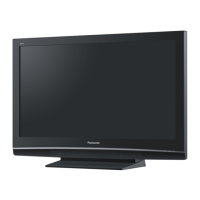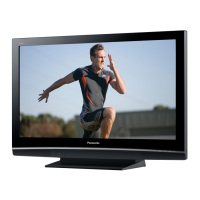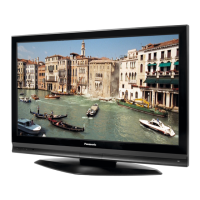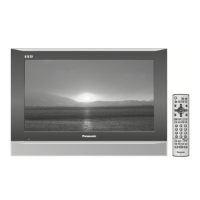Do you have a question about the Panasonic Viera TH-42PX8B and is the answer not in the manual?
Ensure safe access and proper use of the TV's mains plug and electrical cord.
Specifies the TV's operating voltage and frequency for safe operation.
Warning against removing the rear cover due to accessible live internal parts.
Caution about potential irreversible ear damage from high headphone volume.
Warning against heat sources to prevent fire hazards and damage.
Advice against unstable surfaces to prevent tipping and injury.
Instructions for safe transportation of the TV to prevent internal damage.
Warning against water exposure to prevent shock or fire.
Importance of maintaining rear ventilation for heat dissipation.
Guidance on clearance for proper heat dissipation around the TV.
Recommendation for approved mounting for stability and safety.
Caution against prolonged display of static images to prevent screen burn-in.
Feature that automatically turns off TV after inactivity to save power.
Advice on placement to avoid electromagnetic interference or sensor issues.
Instructions for gently cleaning the TV's display panel.
Guidance on cleaning the TV's outer casing and stand.
Procedure for cleaning the mains plug to ensure electrical safety.
Lists all items included in the TV package for initial setup.
Lists accessories available for separate purchase to enhance functionality.
Step-by-step guide to assemble the TV's pedestal securely.
Instructions on how to securely attach the TV to the assembled pedestal.
Overview of the TV's physical controls and indicators.
Diagram showing how to connect an aerial to the TV for signal reception.
Diagram for connecting external video devices like DVD recorders or VCRs.
First steps to initiate the automatic channel and program setup process.
Guidance on entering personal identification information during setup.
Step to choose the preferred viewing environment for picture settings.
Explains how to navigate menus using the remote control buttons.
Describes the on-screen help feature for user guidance.
Instructions on how to turn on the TV.
How to switch between digital (DVB) and analogue broadcast signal types.
Steps to choose a TV channel using the remote control.
How to view programme and broadcast information on screen.
How to check and adjust settings for the currently viewed program.
How to set the TV to turn off automatically after a specified period.
Adjusting the picture's aspect ratio for optimal viewing experience.
Instructions for viewing teletext services in DVB mode.
Explains teletext navigation using remote control buttons.
Explanation of FASTEXT and List modes for teletext page selection.
How to switch between FASTEXT and List modes for teletext access.
Details on HOLD, INDEX, View subtitles, and multi-window functions.
Functions for storing favorite pages and viewing sub-pages.
Allows watching TV while teletext pages are being updated.
How to view the program guide in landscape or portrait layouts.
How to move between previous and next days in the TV Guide.
How to filter programme lists by type or category in DVB mode.
How to watch, view details, or set timer programming for guide events.
Recording the current program immediately using TV Guide information.
How to view and manage advertisements displayed through the system.
Steps to power on the TV for viewing external equipment.
Accessing the menu to choose the correct input for external devices.
Table showing terminal compatibility and remote control operation for equipment.
Steps to access the TV's main menu system.
How to select and move between different menu categories.
Steps to select specific settings and make adjustments.
Methods for inputting characters and navigating menu pages.
Instructions for resetting various TV settings to default.
A detailed list of menu items and their available adjustments.
General guide on navigating and utilizing the TV's menu system.
Details on menu options for Timer Programming, Link Settings, Tuning, etc.
How to switch to DVB mode to access advanced settings.
Steps to access the main Setup menu for DVB configurations.
Accessing specific DVB features like CI modules and software updates.
Information on using Common Interface modules for pay-TV and software updates.
Choosing between DVB or Analogue mode for programme editing.
Steps to access Setup menu for DVB Profile Edit, Service Lists, or Child Lock.
How to hide or delete unwanted TV channels from lists.
Renaming and reordering analogue TV channels.
Setting parental controls and locking specific channels or inputs.
Choosing between DVB or Analogue mode for channel tuning.
Steps to access the channel tuning options via the Setup menu.
Choosing specific tuning operations like Auto Setup or Manual Tuning.
Automatically scanning for all available DVB or Analogue channels.
Manually tuning specific DVB channels by frequency.
Manually tuning specific Analogue channels.
Automatically adding new digital broadcast services.
Setting alerts for new service discoveries and their setup.
Assessing the quality and strength of DVB signal reception.
Steps to access the main Setup menu.
Selecting 'Shipping Condition' to reset all TV settings to factory defaults.
Steps to access the main Setup menu.
Selecting 'Owner ID' to set PIN and personal information.
Entering a PIN and personal details for ownership identification.
Steps to access the main Setup menu.
Selecting 'Input Labels' to customize input terminal names.
Customizing names for TV input ports for easier selection.
Freely naming input terminals using the on-screen keyboard.
Setting up timed recordings for TV programs using the menu.
Initiating the timer programming process with program details.
Configuring program, date, time, and subtitle preferences for recording.
Overview of features and compatibility for Q-Link and VIERA Link.
Diagrams showing how to connect devices for Q-Link and VIERA Link.
Detailed explanation of setting up and using the Q-Link feature.
Recording the current program immediately using Q-Link.
Information on VIERA Link features and HDAVI Control compatibility.
Steps needed before using VIERA Link and overview of its capabilities.
Details on specific VIERA Link functions like Direct TV Recording.
How to control connected equipment menus using the TV remote.
How to control theatre speaker volume and selection via VIERA Link.
Diagrams showing recommended connections for various external devices.
Table showing terminal compatibility with different types of equipment.
Explanation of the automatic aspect ratio adjustment feature for optimal images.
Information on connecting devices via HDMI for high-definition output.
Process for downloading and installing TV software updates.
Pinout details for various connection terminals.
List of compatible input signal formats for COMPONENT and HDMI.
Troubleshooting steps for image noise, no image, or S-Video issues.
Solutions for missing sound, low volume, or unusual sound.
Solutions for Q-Link, VIERA Link, and HDMI connection problems.
Solutions for recording start issues, screen spots, and contrast problems.
Solutions for chaotic, blurry, distorted, or unusual image displays.
Solutions for TV standby issues and non-functional remote controls.
Meaning of messages related to tuning, confirmations, and signal status.
Meaning of messages regarding features, operations, and system time.
Meaning of messages about new services, software versions, and service availability.
Meaning of messages related to recording, PIN errors, and system status.
Meaning of messages concerning software updates and timer programming.
Details regarding trademarks and licensing of technologies used in the TV.
Definitions of technical terms and abbreviations used in the manual.
Details on power consumption, screen size, and pixel count.
Audio output, headphone specs, and broadcast reception systems.
Details of available input and output terminals and their specifications.
TV dimensions and weight specifications.
Contact details for customer support and technical assistance.
Information on ordering accessories and products directly from Panasonic.
Ensure safe access and proper use of the TV's mains plug and electrical cord.
Specifies the TV's operating voltage and frequency for safe operation.
Warning against removing the rear cover due to accessible live internal parts.
Caution about potential irreversible ear damage from high headphone volume.
Warning against heat sources to prevent fire hazards and damage.
Advice against unstable surfaces to prevent tipping and injury.
Instructions for safe transportation of the TV to prevent internal damage.
Warning against water exposure to prevent shock or fire.
Importance of maintaining rear ventilation for heat dissipation.
Guidance on clearance for proper heat dissipation around the TV.
Recommendation for approved mounting for stability and safety.
Caution against prolonged display of static images to prevent screen burn-in.
Feature that automatically turns off TV after inactivity to save power.
Advice on placement to avoid electromagnetic interference or sensor issues.
Instructions for gently cleaning the TV's display panel.
Guidance on cleaning the TV's outer casing and stand.
Procedure for cleaning the mains plug to ensure electrical safety.
Lists all items included in the TV package for initial setup.
Lists accessories available for separate purchase to enhance functionality.
Step-by-step guide to assemble the TV's pedestal securely.
Instructions on how to securely attach the TV to the assembled pedestal.
Overview of the TV's physical controls and indicators.
Diagram showing how to connect an aerial to the TV for signal reception.
Diagram for connecting external video devices like DVD recorders or VCRs.
First steps to initiate the automatic channel and program setup process.
Guidance on entering personal identification information during setup.
Step to choose the preferred viewing environment for picture settings.
Explains how to navigate menus using the remote control buttons.
Describes the on-screen help feature for user guidance.
Instructions on how to turn on the TV.
How to switch between digital (DVB) and analogue broadcast signal types.
Steps to choose a TV channel using the remote control.
How to view programme and broadcast information on screen.
How to check and adjust settings for the currently viewed program.
How to set the TV to turn off automatically after a specified period.
Adjusting the picture's aspect ratio for optimal viewing experience.
Instructions for viewing teletext services in DVB mode.
Explains teletext navigation using remote control buttons.
Explanation of FASTEXT and List modes for teletext page selection.
How to switch between FASTEXT and List modes for teletext access.
Details on HOLD, INDEX, View subtitles, and multi-window functions.
Functions for storing favorite pages and viewing sub-pages.
Allows watching TV while teletext pages are being updated.
How to view the program guide in landscape or portrait layouts.
How to move between previous and next days in the TV Guide.
How to filter programme lists by type or category in DVB mode.
How to watch, view details, or set timer programming for guide events.
Recording the current program immediately using TV Guide information.
How to view and manage advertisements displayed through the system.
Steps to power on the TV for viewing external equipment.
Accessing the menu to choose the correct input for external devices.
Table showing terminal compatibility and remote control operation for equipment.
Steps to access the TV's main menu system.
How to select and move between different menu categories.
Steps to select specific settings and make adjustments.
Methods for inputting characters and navigating menu pages.
Instructions for resetting various TV settings to default.
A detailed list of menu items and their available adjustments.
General guide on navigating and utilizing the TV's menu system.
Details on menu options for Timer Programming, Link Settings, Tuning, etc.
How to switch to DVB mode to access advanced settings.
Steps to access the main Setup menu for DVB configurations.
Accessing specific DVB features like CI modules and software updates.
Information on using Common Interface modules for pay-TV and software updates.
Choosing between DVB or Analogue mode for programme editing.
Steps to access Setup menu for DVB Profile Edit, Service Lists, or Child Lock.
How to hide or delete unwanted TV channels from lists.
Renaming and reordering analogue TV channels.
Setting parental controls and locking specific channels or inputs.
Choosing between DVB or Analogue mode for channel tuning.
Steps to access the channel tuning options via the Setup menu.
Choosing specific tuning operations like Auto Setup or Manual Tuning.
Automatically scanning for all available DVB or Analogue channels.
Manually tuning specific DVB channels by frequency.
Manually tuning specific Analogue channels.
Automatically adding new digital broadcast services.
Setting alerts for new service discoveries and their setup.
Assessing the quality and strength of DVB signal reception.
Steps to access the main Setup menu.
Selecting 'Shipping Condition' to reset all TV settings to factory defaults.
Steps to access the main Setup menu.
Selecting 'Owner ID' to set PIN and personal information.
Entering a PIN and personal details for ownership identification.
Steps to access the main Setup menu.
Selecting 'Input Labels' to customize input terminal names.
Customizing names for TV input ports for easier selection.
Freely naming input terminals using the on-screen keyboard.
Setting up timed recordings for TV programs using the menu.
Initiating the timer programming process with program details.
Configuring program, date, time, and subtitle preferences for recording.
Overview of features and compatibility for Q-Link and VIERA Link.
Diagrams showing how to connect devices for Q-Link and VIERA Link.
Detailed explanation of setting up and using the Q-Link feature.
Recording the current program immediately using Q-Link.
Information on VIERA Link features and HDAVI Control compatibility.
Steps needed before using VIERA Link and overview of its capabilities.
Details on specific VIERA Link functions like Direct TV Recording.
How to control connected equipment menus using the TV remote.
How to control theatre speaker volume and selection via VIERA Link.
Diagrams showing recommended connections for various external devices.
Table showing terminal compatibility with different types of equipment.
Explanation of the automatic aspect ratio adjustment feature for optimal images.
Information on connecting devices via HDMI for high-definition output.
Process for downloading and installing TV software updates.
Pinout details for various connection terminals.
List of compatible input signal formats for COMPONENT and HDMI.
Troubleshooting steps for image noise, no image, or S-Video issues.
Solutions for missing sound, low volume, or unusual sound.
Solutions for Q-Link, VIERA Link, and HDMI connection problems.
Solutions for recording start issues, screen spots, and contrast problems.
Solutions for chaotic, blurry, distorted, or unusual image displays.
Solutions for TV standby issues and non-functional remote controls.
Meaning of messages related to tuning, confirmations, and signal status.
Meaning of messages regarding features, operations, and system time.
Meaning of messages about new services, software versions, and service availability.
Meaning of messages related to recording, PIN errors, and system status.
Meaning of messages concerning software updates and timer programming.
Details regarding trademarks and licensing of technologies used in the TV.
Definitions of technical terms and abbreviations used in the manual.
Details on power consumption, screen size, and pixel count.
Audio output, headphone specs, and broadcast reception systems.
Details of available input and output terminals and their specifications.
TV dimensions and weight specifications.
Contact details for customer support and technical assistance.
Information on ordering accessories and products directly from Panasonic.
| Screen Size | 42 inches |
|---|---|
| Display Type | Plasma |
| Resolution | 1024 x 768 |
| Aspect Ratio | 16:9 |
| Brightness | 1500 cd/m² |
| Contrast Ratio | 15000:1 |
| HDMI Ports | 2 |
| Component Video Inputs | 2 |
| Composite Input | 1 |
| S-Video Input | 1 |
| Speakers | 2 x 10W |
| VGA Input | 1 |
| SCART Inputs | 2 |
| Headphone Jack | Yes |
| Power Consumption | 295W |
| PC Input | 1 (VGA) |
| Viewing Angle | 160° |











